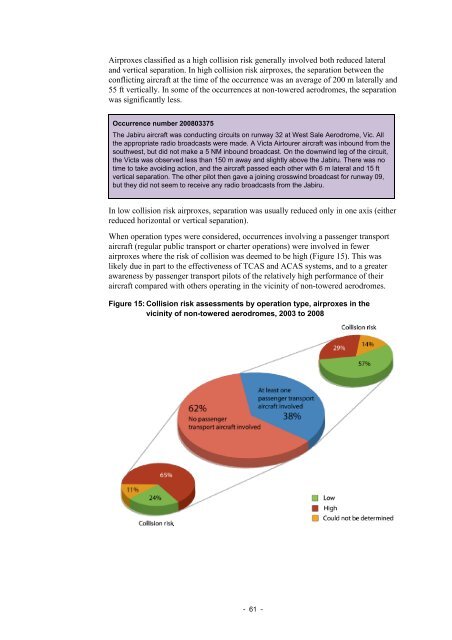Safety in the vicinity of non-towered aerodromes - Australian ...
Safety in the vicinity of non-towered aerodromes - Australian ...
Safety in the vicinity of non-towered aerodromes - Australian ...
You also want an ePaper? Increase the reach of your titles
YUMPU automatically turns print PDFs into web optimized ePapers that Google loves.
Airproxes classified as a high collision risk generally <strong>in</strong>volved both reduced lateral<br />
and vertical separation. In high collision risk airproxes, <strong>the</strong> separation between <strong>the</strong><br />
conflict<strong>in</strong>g aircraft at <strong>the</strong> time <strong>of</strong> <strong>the</strong> occurrence was an average <strong>of</strong> 200 m laterally and<br />
55 ft vertically. In some <strong>of</strong> <strong>the</strong> occurrences at <strong>non</strong>-<strong>towered</strong> <strong>aerodromes</strong>, <strong>the</strong> separation<br />
was significantly less.<br />
Occurrence number 200803375<br />
The Jabiru aircraft was conduct<strong>in</strong>g circuits on runway 32 at West Sale Aerodrome, Vic. All<br />
<strong>the</strong> appropriate radio broadcasts were made. A Victa Airtourer aircraft was <strong>in</strong>bound from <strong>the</strong><br />
southwest, but did not make a 5 NM <strong>in</strong>bound broadcast. On <strong>the</strong> downw<strong>in</strong>d leg <strong>of</strong> <strong>the</strong> circuit,<br />
<strong>the</strong> Victa was observed less than 150 m away and slightly above <strong>the</strong> Jabiru. There was no<br />
time to take avoid<strong>in</strong>g action, and <strong>the</strong> aircraft passed each o<strong>the</strong>r with 6 m lateral and 15 ft<br />
vertical separation. The o<strong>the</strong>r pilot <strong>the</strong>n gave a jo<strong>in</strong><strong>in</strong>g crossw<strong>in</strong>d broadcast for runway 09,<br />
but <strong>the</strong>y did not seem to receive any radio broadcasts from <strong>the</strong> Jabiru.<br />
In low collision risk airproxes, separation was usually reduced only <strong>in</strong> one axis (ei<strong>the</strong>r<br />
reduced horizontal or vertical separation).<br />
When operation types were considered, occurrences <strong>in</strong>volv<strong>in</strong>g a passenger transport<br />
aircraft (regular public transport or charter operations) were <strong>in</strong>volved <strong>in</strong> fewer<br />
airproxes where <strong>the</strong> risk <strong>of</strong> collision was deemed to be high (Figure 15). This was<br />
likely due <strong>in</strong> part to <strong>the</strong> effectiveness <strong>of</strong> TCAS and ACAS systems, and to a greater<br />
awareness by passenger transport pilots <strong>of</strong> <strong>the</strong> relatively high performance <strong>of</strong> <strong>the</strong>ir<br />
aircraft compared with o<strong>the</strong>rs operat<strong>in</strong>g <strong>in</strong> <strong>the</strong> vic<strong>in</strong>ity <strong>of</strong> <strong>non</strong>-<strong>towered</strong> <strong>aerodromes</strong>.<br />
Figure 15: Collision risk assessments by operation type, airproxes <strong>in</strong> <strong>the</strong><br />
vic<strong>in</strong>ity <strong>of</strong> <strong>non</strong>-<strong>towered</strong> <strong>aerodromes</strong>, 2003 to 2008<br />
- 61 -
















